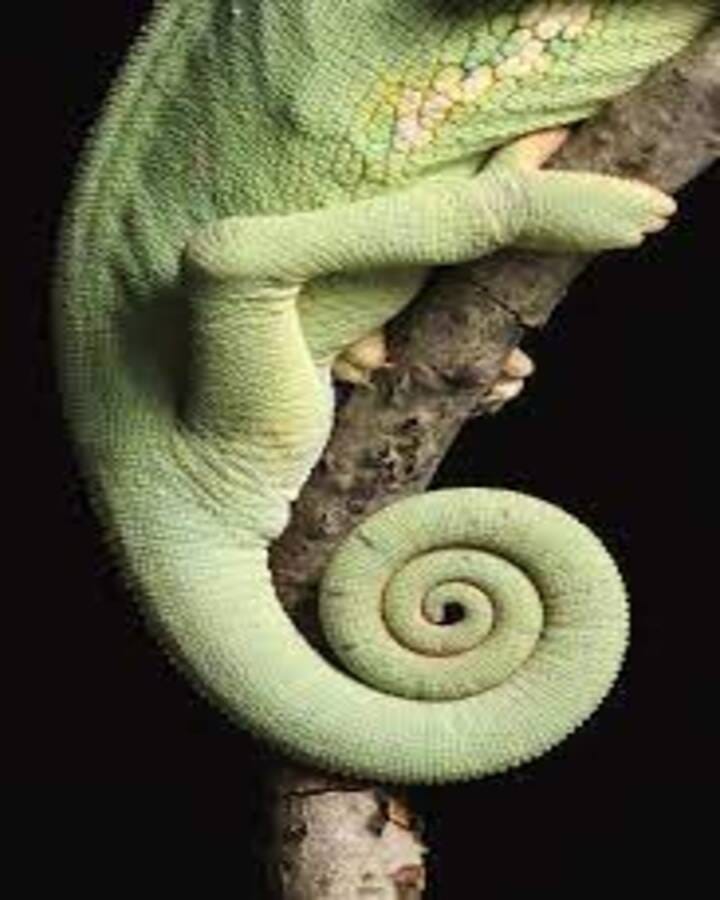
Image Credit – Hema
Chameleons are among the most fascinating reptiles in the world, known for their incredible ability to change color and their independently moving eyes. However, one of their most remarkable features is their chameleon tails. Unlike many other reptiles, chameleons have prehensile tails, meaning they can grasp and hold onto objects. This adaptation helps them navigate their arboreal (tree-dwelling) environment with ease.
In this blog, we’ll explore the structure, function, and unique behaviors associated with chameleon tails, as well as some interesting facts that make these reptiles truly special. Whether you’re a reptile enthusiast or just curious about these amazing creatures, keep reading to learn more!
Chameleon Tails: Unique Adaptations and Fascinating Facts

What Makes Chameleon Tails Unique?
1. Prehensile Functionality
Unlike many lizards that have tails primarily for balance, chameleon tails act as an extra limb. They can wrap around branches and grip firmly, providing extra stability while climbing. This prehensile ability allows them to navigate through trees efficiently, preventing falls and helping them stay hidden from predators.
2. Tails That Don’t Regrow
Many reptiles, like geckos and some lizards, can detach their tails as a defense mechanism and later regrow them. However, chameleons cannot regenerate their tails. If a chameleon loses its tail due to injury, it will not grow back, making its tail an even more vital part of its survival.
3. A Natural Counterbalance
A chameleon’s tail plays a key role in maintaining balance while climbing. Since their legs are adapted for gripping thin branches, the tail serves as a counterbalance, allowing them to move smoothly without losing stability.
4. Tail Curling Behavior
One of the most distinctive behaviors of chameleons is their tendency to curl their tails when resting or feeling secure. This curling can indicate a relaxed state, but it may also serve as camouflage by mimicking coiled vines or small twigs in their natural habitat.
5. Communication and Mood Indicators
Chameleons use their tails, along with body posture and color changes, to communicate their mood. A tightly curled tail might indicate stress or defensiveness, while a relaxed tail suggests comfort and security.
The Role of Chameleon Tails in Their Habitat
Adaptation to an Arboreal Lifestyle
Chameleons are primarily tree dwellers, and their tails are essential for their arboreal lifestyle. The prehensile grip of their tails helps them stay secure on branches while they use their long tongues to catch insects. Without their strong tails, climbing and maneuvering through trees would be much more difficult.
Blending in With the Environment
In addition to color-changing skin, chameleon tails aid in camouflage. When curled up, their tails resemble vines, helping them blend into their surroundings and avoid predators.
Hunting and Defense
Although their tails are not used for attacking prey or defending against predators, they help stabilize the chameleon when it strikes with its tongue. By keeping a firm grip on a branch with both its feet and tail, a chameleon can extend its tongue with incredible precision to capture insects.
Interesting Facts About Chameleon Tails
- Each species has a different tail length – Some chameleons have longer tails than their bodies, while others have shorter tails depending on their environment.
- Chameleons rarely walk on the ground – Their tails help them stay in trees, reducing the risk of being caught by predators.
- A chameleon’s tail is made of strong, flexible vertebrae – This allows it to move with great control and strength.
- Tails are used for emotional expression – A rigid, straight tail can signal alertness or fear, while a loose curl means the chameleon is comfortable.
How to Care for a Chameleon’s Tail in Captivity
If you own a pet chameleon, keeping its tail healthy is important. Here are some care tips:
- Provide plenty of climbing space – Chameleons need branches and vines to use their tails properly.
- Monitor for injuries – Since chameleon tails don’t regrow, it’s crucial to prevent tail injuries by keeping them in a safe enclosure.
- Ensure proper humidity levels – Dry conditions can cause dehydration, which may affect a chameleon’s mobility, including its tail function.
- Avoid handling the tail too much – Chameleons rely on their tails for stability, so excessive handling can stress them out.
A chameleon’s tail is more than just an extension of its body—it’s a vital tool for climbing, balancing, and even expressing emotions. Their prehensile tails allow them to navigate their arboreal world with ease, while their unique curling behavior helps them stay camouflaged and secure. Unlike some lizards, chameleons cannot regrow their tails, making it essential for them to protect this important feature.
If you’ve ever observed a chameleon’s tail in action, you know just how fascinating these reptiles are! Have you noticed any interesting tail behaviors in pet or wild chameleons? Let us know in the comments—we’d love to hear your experiences!
Frequently Asked Questions
Why do chameleons curl their tails?
Chameleons curl their tails for balance, security, and camouflage. A curled tail can signal relaxation or mimic vines to blend into their surroundings. Some species also tighten their tails when they feel stressed or defensive.
Can chameleons lose their tails like other lizards?
No, unlike geckos or some lizards, chameleons cannot regrow their tails if lost due to injury. Their prehensile tails are crucial for climbing and stability, so they must be protected to ensure the chameleon’s survival.
How does a chameleon’s tail help with climbing?
A chameleon’s tail acts like a fifth limb, wrapping around branches for extra grip and stability. This helps them move securely through trees without falling, especially when stretching to catch prey with their long tongues.







